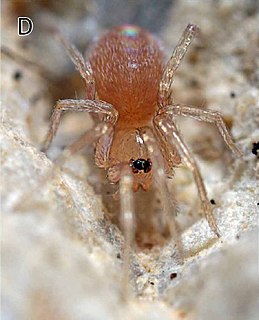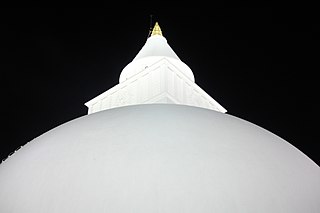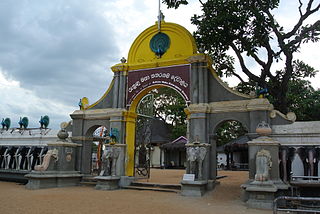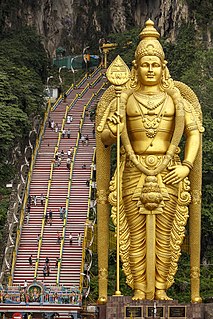
Wolf spiders are members of the family Lycosidae, from the Ancient Greek word "λύκος" meaning "wolf". They are robust and agile hunters with excellent eyesight. They live mostly in solitude and hunt alone, and do not spin webs. Some are opportunistic hunters pouncing upon prey as they find it or even chasing it over short distances. Some wait for passing prey in or near the mouth of a burrow.

Jumping spiders or the Salticidae are a family of spiders. As of 2019, it contained over 600 described genera and over 6000 described species, making it the largest family of spiders at 13% of all species. Jumping spiders have some of the best vision among arthropods and use it in courtship, hunting, and navigation. Although they normally move unobtrusively and fairly slowly, most species are capable of very agile jumps, notably when hunting, but sometimes in response to sudden threats or crossing long gaps. Both their book lungs and tracheal system are well-developed, and they use both systems. Jumping spiders are generally recognized by their eye pattern. All jumping spiders have four pairs of eyes, with the anterior median pair being particularly large.

Huntsman spiders, members of the family Sparassidae, are known by this name because of their speed and mode of hunting. They are also called giant crab spiders because of their size and appearance. Larger species sometimes are referred to as wood spiders, because of their preference for woody places. In southern Africa the genus Palystes are known as rain spiders or lizard-eating spiders. Commonly they are confused with baboon spiders from the Mygalomorphae infraorder, which are not closely related.

Latrodectus is a broadly distributed genus of spiders with several species that, together, are referred to as true widows. This group is composed of those often loosely called black widow spiders, brown widow spiders, and similar spiders. However, such general "common names" are of limited use as the diversity of species is much greater. A member of the family Theridiidae, this genus contains 32 species, which include several North American "black widows". In addition to these in North America are also the red widow Latrodectus bishopi and the brown widow Latrodectus geometricus, which, in addition to North America, has a much wider geographic distribution. Elsewhere, others include the European black widow, the Australian redback black widow, several different species in Southern Africa that can be called Button spiders, and the South American black widow spiders. Species vary widely in size. In most cases, the females are dark-coloured, but some may have lighter bodies or even reddish. Many can have red, white or brown markings on the upper-side (dorsal) of the abdomen. Some can be readily identifiable by reddish markings on the central underside (ventral) abdomen, which are often hourglass-shaped.

The Araneomorphae are an infraorder of spiders. They are distinguished by having chelicerae (fangs) that point diagonally forward and cross in a pinching action, in contrast to the Mygalomorphae, where they point straight down. Most of the spiders that people encounter in daily life belong to the Araneomorphae.

Oonopidae, also known as goblin spiders, is a family of spiders consisting of over 1,600 described species in about 113 genera worldwide, with total species diversity estimated at 2000 to 2500 species. The type genus of the family is OonopsKeyserling, 1835.
Bogar or Bhogar or Boganathar or Boyang was a Tamil siddhar who lived sometime between 550 and 300 BC. Described in several traditions and texts, he describes his native roots in his book "Bogar 7000". Bogar went from Tamil Nadu to China and taught about enlightenment, this is also mentioned in his book Bogar 7000. Bogar is said to be in "Nirvikalpa Samadhi" below the sanctum sanctorum of Palani Murugan hill temple,temple. The Tamraparniyan sea route was adopted by Bogar in his travels from South India to China via Sri Lanka. A disciple of Agastya's teachings, Bogar himself taught meditation, alchemy, yantric designs and Kriya yoga at the Kataragama Murugan shrine, inscribing a yantric geometric design etched onto a metallic plate and installing it at the sanctum sanctorum of the Kataragama complex. Bogar is one of the earliest pilgrims to have traversed the Murugan Tiruppadai of Sri Lanka. According to legends and the temple scriptures of Palani temple, Bogar created the idol of Murugan at the hill temple in Palani by mixing nine poisonous herbs (Navapashanam) using a unique procedure. He also established the temple for Murugan in Poombarai Kuzhanthai Velappar temple Kodaikanal Tamilnadu,India. There is an extant statue of lord Murugan in Navapashanam. The milk that was poured on this statue has been said to have mixed with some of the herbs thereby proving to be an effective cure for the diseases during the time The priests of Palani Murugan temple were said to have been the descendants of Pulipani, one of Bogar's students, until the sixteenth century.

Kiri Vehera is an ancient stupa situated in Kataragama, Sri Lanka. This stupa probably dates back to the 3rd century BC and is believed to have been built by King Mahasena, a regional ruler of Kataragama area. One of the most popular Buddhist pilgrimage sites in the country, Kiri Vehera is among the Solosmasthana, the 16 most sacred Buddhist pilgrimage sites of ancient Sri Lanka. This stupa which is 95 ft. in height with a circumference of 280 ft. is located 800 m North to the famous Ruhunu Maha Kataragama Devalaya. Venerable Kobawaka Dhamminda Thera is the present Chief Prelate of Kirivehera Rajamaha Viharaya.

Tarantulas comprise a group of large and often ″hairy″ spiders of the family Theraphosidae. Currently, about 1,000 species have been identified. The term tarantula is usually used to describe members of the family Theraphosidae, although many other members of the same infraorder (Mygalomorphae) are commonly referred to as "tarantulas" or "false tarantulas". Some of the more common species have become popular in the exotic pet trade. Many New World species kept as pets have urticating hairs that can cause irritation to the skin, and in extreme cases, cause damage to the eyes.

Kataragama deviyo is a guardian deity of Sri Lanka. A popular deity who is considered to be very powerful, shrines dedicated to Kataragama deviyo are found in many places of the country. Sinhalese Buddhists believe him also as a divine patron of the Buddha Sasana in Sri Lanka. An ancient temple dedicated to God Kataragama, known as Ruhunu Maha Kataragama Devalaya is situated in the South-Eastern town of Kataragama in Monaragala District of Uva Province.

Spiders are air-breathing arthropods that have eight legs, chelicerae with fangs generally able to inject venom, and spinnerets that extrude silk. They are the largest order of arachnids and rank seventh in total species diversity among all orders of organisms. Spiders are found worldwide on every continent except for Antarctica, and have become established in nearly every habitat with the exceptions of air and sea colonization. As of July 2019, at least 48,200 spider species, and 120 families have been recorded by taxonomists. However, there has been dissension within the scientific community as to how all these families should be classified, as evidenced by the over 20 different classifications that have been proposed since 1900.

Kataragama temple in Kataragama, Sri Lanka, is a temple complex dedicated to Buddhist guardian deity Kataragama deviyo and Hindu War God Murugan. It is one of the few religious sites in Sri Lanka that is venerated by the Buddhists, Hindus, Muslims and the Vedda people. For most of the past millennia, it was a jungle shrine very difficult to access; today it is accessible by an all-weather road. The shrines and the nearby Kiri Vehera are managed by Buddhists, the shrines dedicated to Teyvāṉai and Shiva are managed by Hindus and the mosque by Muslims.

Kataragama is a pilgrimage town sacred to Buddhist, Hindu and indigenous Vedda people of Sri Lanka. People from South India also go there to worship. The town has the Kataragama temple, a shrine dedicated to Skanda Kumara also known as Kataragama deviyo. Kataragama is located in the Monaragala District of Uva province, Sri Lanka. It is 228 km ESE of Colombo, the capital of Sri Lanka. Although Kataragama was a small village in medieval times, today it is a fast-developing township surrounded by jungle in the southeastern region of Sri Lanka.

Kartikeya, also known as Skanda, Kumara, Murugan and Subrahmanya, is the Hindu god of war. He is the son of Parvati and Shiva, brother of Ganesha, and a god whose life story has many versions in Hinduism. An important deity in the Indian subcontinent since ancient times, Kartikeya is particularly popular and predominantly worshipped in South India, Sri Lanka and Malaysia as Murugan.
The World Spider Catalog (WSC) is an online searchable database concerned with spider taxonomy. It aims to list all accepted families, genera and species, as well as provide access to the related taxonomic literature. The WSC began as a series of individual web pages in 2000, created by Norman I. Platnick of the American Museum of Natural History. After Platnick's retirement in 2014, the Natural History Museum of Bern (Switzerland) took over the catalog, converting it to a relational database.
Aprusia strenuus is a species of spider of the genus Aprusia. It is endemic to Sri Lanka.
Aprusia is a genus of goblin spiders in the family Oonopidae, containing five accepted species. four species are endemic to Sri Lanka and the other species is endemic to India.
Aprusia veddah, is a species of oonopid spider of the genus Aprusia. It is endemic to Sri Lanka.
Aprusia vestigator, is a species of spider of the genus Aprusia. It is endemic to Sri Lanka.












